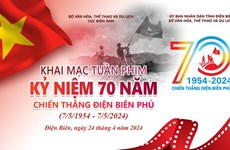Rich Phu Yen culture beckons
The southern central province of Phu Yen is well-known for its undulating coastline and majestic seascapes.
The southern central province of Phu Yen is well-known for its undulating coastline and majestic seascapes.
Those who decide to visit the province should devote a day to exploring Tuy An district, about 35km away to Tuy Hoa City – the provincial capital.
A visit to the district allows you to explore the richness of the local culture while also getting some interesting insights into Vietnam's history as well.
Mang Lang Church is a famed destination for Catholic pilgrims rather than a tourist attraction but, its location, on the way to the nearby Da Dia Cliffs, makes it easy to visit.
The church was built in An Thach commune, Tuy An district in 1892 by French priest Joseph de La Cassagne. It gets its name from the surrounding mang lang trees, which have oval leaves and purple and pink blossoms. There is still an old table made from mang lang wood in the church, a fixture that has been here since the church opened. The Gothic style church, which is the oldest church in the province, is situated on grounds that cover 5,000sq.m. A cross is positioned in the middle of two steeples. The building, originally painted white, has turned a dark grey with the passage of time.
Catholic visitors may be interesting in checking out documents kept at the church about the life of Saint Andrew Phu Yen. His statue stands solemnly on a small hill in the church yard. In addition, there is a small chamber which was built inside an artificial hill. The basement is filled with sculptures inspired by the life of the Saint.
"The Blessed Andrew Phu Yen is a great source of honour for our Qui Nhon Diocese and Mang Lang Parish," said local priest Pham Canh Hien.
"In early the 17th century, one of the Jesuit missionaries to visit our ancestors was Alexandre de Rhodes, and it was he who educated and baptised Andrew Phu Yen. Afterwards Andrew Phu Yen was privileged to receive his martyrdom on July 26, 1644, becoming the First Witness of the Vietnamese Church."
Through the faithful example and prayers of Saint Andrew, Mang Lang village became the cradle of the Catholic missionary movement in Phu Yen province and continues to be a destination for pilgrims and the site of Catholic youth festivals.
Visitors can view relics related to the history of the church, including the first book of Christianity in Eight Days, an early example of a book written in Vietnamese romanised script. It was printed in 1651 in Rome, Italy. The book was written by de Rhodes (1593-1660), a French Jesuit missionary and lexicographer.
De Rhodes, also known as Father Dac Lo, was among the first Western missionaries who created the script, basing it on the Roman alphabet while adding nine accent marks or diacritics – four of them to create additional sounds, and the other five to indicate tone. The many diacritics, often two on the same letter, make written Vietnamese easily recognisable.
It's about 10km from Mang Lang Church to Tu Quang Pagoda in An Dan commune in the same district. The pagoda, built in 1797, is better known as the Da Trang (White Stone) Pagoda, as it is located in an area rich with white marble.
Xuan Dai Mountain lies behind the pagoda, and the Ngan Son and Phu My rivers are also situated nearby.
Da Trang Pagoda is famous for its group of ‘grave towers' or stupas. Every year, on the tenth day of lunar January, local people hold a festival to commemorate monks and heroes who contributed to the nation, including Tran Cao Van and Vo Tru.
The two national heroes joined the uprising led by Le Thanh Phuong (1825-87), a leader of the Can Vuong (Aid the King) Movement in Phu Yen province.
The movement was a large-scale Vietnamese insurgency between 1885 and 1887 to expel the French colonialist in support of the boy emperor Ham Nghi, the eighth emperor of the Nguyen dynasty who was only on the throne for a year (1884-85) as the leader of an independent Vietnam.
Today the pagoda is a great place to visit during the spring and summer, when the mangoes in the pagoda's orchard are ripening. The mangoes have long been known for their delicious taste and pleasant scent. The fruit is considered a typical speciality of the land and used to be offered to kings and members of the royal family.
The next stop is An Tho Citadel in the same commune. It was the provincial capital of Phu Yen from 1836-99.
The citadel is only 400m from the Phu Ngan River to the south and about 150m from the Vet River, and facilitating easy access to the sea when travelling by boat.
An Tho Citadel was recognised by the Ministry of Culture as a National Historic Heritage in 2007 and 12,5 billion VND was invested for preservation and restoration work.
The project was completed in time for Phu Yen's 400th anniversary and the opening ceremony for National Tourism Year in the southern central coastal provinces and Phu Yen 2011./.
Those who decide to visit the province should devote a day to exploring Tuy An district, about 35km away to Tuy Hoa City – the provincial capital.
A visit to the district allows you to explore the richness of the local culture while also getting some interesting insights into Vietnam's history as well.
Mang Lang Church is a famed destination for Catholic pilgrims rather than a tourist attraction but, its location, on the way to the nearby Da Dia Cliffs, makes it easy to visit.
The church was built in An Thach commune, Tuy An district in 1892 by French priest Joseph de La Cassagne. It gets its name from the surrounding mang lang trees, which have oval leaves and purple and pink blossoms. There is still an old table made from mang lang wood in the church, a fixture that has been here since the church opened. The Gothic style church, which is the oldest church in the province, is situated on grounds that cover 5,000sq.m. A cross is positioned in the middle of two steeples. The building, originally painted white, has turned a dark grey with the passage of time.
Catholic visitors may be interesting in checking out documents kept at the church about the life of Saint Andrew Phu Yen. His statue stands solemnly on a small hill in the church yard. In addition, there is a small chamber which was built inside an artificial hill. The basement is filled with sculptures inspired by the life of the Saint.
"The Blessed Andrew Phu Yen is a great source of honour for our Qui Nhon Diocese and Mang Lang Parish," said local priest Pham Canh Hien.
"In early the 17th century, one of the Jesuit missionaries to visit our ancestors was Alexandre de Rhodes, and it was he who educated and baptised Andrew Phu Yen. Afterwards Andrew Phu Yen was privileged to receive his martyrdom on July 26, 1644, becoming the First Witness of the Vietnamese Church."
Through the faithful example and prayers of Saint Andrew, Mang Lang village became the cradle of the Catholic missionary movement in Phu Yen province and continues to be a destination for pilgrims and the site of Catholic youth festivals.
Visitors can view relics related to the history of the church, including the first book of Christianity in Eight Days, an early example of a book written in Vietnamese romanised script. It was printed in 1651 in Rome, Italy. The book was written by de Rhodes (1593-1660), a French Jesuit missionary and lexicographer.
De Rhodes, also known as Father Dac Lo, was among the first Western missionaries who created the script, basing it on the Roman alphabet while adding nine accent marks or diacritics – four of them to create additional sounds, and the other five to indicate tone. The many diacritics, often two on the same letter, make written Vietnamese easily recognisable.
It's about 10km from Mang Lang Church to Tu Quang Pagoda in An Dan commune in the same district. The pagoda, built in 1797, is better known as the Da Trang (White Stone) Pagoda, as it is located in an area rich with white marble.
Xuan Dai Mountain lies behind the pagoda, and the Ngan Son and Phu My rivers are also situated nearby.
Da Trang Pagoda is famous for its group of ‘grave towers' or stupas. Every year, on the tenth day of lunar January, local people hold a festival to commemorate monks and heroes who contributed to the nation, including Tran Cao Van and Vo Tru.
The two national heroes joined the uprising led by Le Thanh Phuong (1825-87), a leader of the Can Vuong (Aid the King) Movement in Phu Yen province.
The movement was a large-scale Vietnamese insurgency between 1885 and 1887 to expel the French colonialist in support of the boy emperor Ham Nghi, the eighth emperor of the Nguyen dynasty who was only on the throne for a year (1884-85) as the leader of an independent Vietnam.
Today the pagoda is a great place to visit during the spring and summer, when the mangoes in the pagoda's orchard are ripening. The mangoes have long been known for their delicious taste and pleasant scent. The fruit is considered a typical speciality of the land and used to be offered to kings and members of the royal family.
The next stop is An Tho Citadel in the same commune. It was the provincial capital of Phu Yen from 1836-99.
The citadel is only 400m from the Phu Ngan River to the south and about 150m from the Vet River, and facilitating easy access to the sea when travelling by boat.
An Tho Citadel was recognised by the Ministry of Culture as a National Historic Heritage in 2007 and 12,5 billion VND was invested for preservation and restoration work.
The project was completed in time for Phu Yen's 400th anniversary and the opening ceremony for National Tourism Year in the southern central coastal provinces and Phu Yen 2011./.










